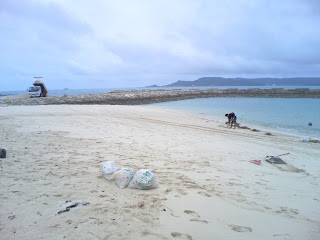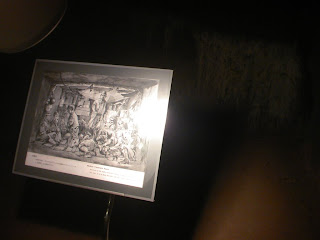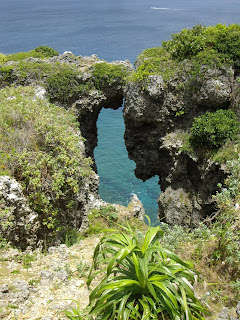 Okinawa
OkinawaSo, the final destination for me on my travels around Japan - Okinawa. I'd decided to pay a visit to the island and a friend I have there as my last trip in Japan, making it a kind of summer holiday after university had finished. Okinawa is the hub of Japan's most southern archipalegeo, and as such is fairly similar in terms of politics to the Channel Islands, in that it's mostly seen as somewhere to retire to, and receives little or no attention in the mainstream media.
As a holiday, it wasn't much of a plan to simply go tourist-crazy, more perhaps see a couple of things and just enjoy being out of Nagoya for the first time in a while. There were a few things I wanted to see though - being interested in history I wanted to visit the place where the Japanese military made its ferocious last stand against the overwhelming American offensive, I'd also heard lots of good things about the aquarium up in the north (largest fish tank in the world, best aquarium in the world). Outside of that it was principally the plan just to see how island life differed from that in the big mainland city. In the first day we just wandered around the island, seeing bits and bobs, like the local Chinese Garden.
...and then the day after that Typhoon Morakot blew past.
During a typhoon the island just battens down the hatches and waits it out. In this case the typhoon only glanced the island, and the most we had was a bit of strong wind and frequent heavy rain, but nothing that would really cause any damage. It was worrying watching what happened to Taiwan and China later in the week - chance that Okinawa itself was spared the worst of it.
The day after was planned to go to the beach, but that was full of driftwood and flotsam from the typhoon, so swimming wasn't allowed. My goal of swimming in a sea warmer than England's was thwarted again.
When the typhoon calmed down a bit, we managed to get out to Okinawa's principle castle, and while I was told it wasn't worth much to actually enter, outside there was a free display of some Okinawan costumes and dancing.
After that we coincidentally met up with another Sheffielder who'd come to the island for an end-of-term holiday as well. We ended up walking a fair way to the military tunnels together, and had a good look around those.
Getting around in Okinawa is the tricky bit. With no trains, you're left with buses and taxis. Buses are fairly cheap (maybe £2 for a trip to the far end of the island), and being no less reliable than English ones are your best bet for getting places. Taxis are more expensive, at perhaps over £5 for the same journey. The undisputed best way of getting around is to own or rent a car, both of which seem to work out cheaper than catching buses all day, especially if there's more than one of you. You'll need an international driving license, before you leave for the country even, so I was limited to the buses and the occasional taxi. The day we went to the aquarium we were kindly given a lift by a Korean student who'd bought his car for around £150 from another student when he arrived.
On the last day I finally managed to get to the aquarium, thanks to the friend of a friend Anyong. He not only drove the long distance (only about 50 miles, but with very slow speed limits) to the north of the island but also showed us other places along the way. That day the typhoon had finally passed entirely and the tropical side of the island had finally showed up.
The aquarium, or perhaps I should say Ocean Expo Park, of which the aquarium was just a small part, was massive, including tropical gardens and various separate houses for dolphins, turtles etc. We didn't have much time to look around though, which was a shame, but makes it certainly worth another visit. The best thing about the aquarium was the variety - even though I've been to Nagoya's aquarium, there was so much at Churaumi that I'd never seen before: the enormous lobster/crabs and sea cucumbers that were more like sea watermelons, upclose ultraviolet tanks of jellyfish, snakes that bury themselves in the sand and look like living grass, fish with the same luminesance that's in your watch, and of course, the enormous fish tank.
Would love to come back here sometime soon, and spend more time going around everything. There are coach tours that contain entry to this place alongside other things in the north of the island, but just this by itself is worth a whole day if not more.
Anyong also had a good sense of where the best "free sample" sweet/cake shops were, and took us to a few of those, noticably "Pineapple Land", where if you walk in through the exit avoiding the large piles of guilt you can get through the gift shop to the "all you can eat" pineapple samples. I've no real idea how they make any money in that place, although they were on the local news for having made the first shipment of pineapples to the mainland.
Heading back home we stopped at the American Village to see the more foreign side of the island. This place is apparently popular for its night-life, which isn't easy to find in an island that's half condensed whitewash city and half vegetation. On this occasion however, there was a Linkin Park concert.
Although I said Okinawa resembles the Channel Islands, it does bear one striking difference in that it was effectively traded to the Americans at the end of WWII for a reprieve of occupation, and the statistic is something like 70% of Okinawa's land is still taken up by American bases. The bases are infamous for incidents of rape - usually drunk GIs picking on young school girls. Those GIs are not answerable to the Okinawan authorities, leaving the actual citizens of the island without any feeling of actual justice. Mainland Japan isn't interested in interfering, preportedly because they see Okinawans as sub-Japanese, but mainly because Okinawa is supposed to be the prime example of Japan/American cooperation, and so they want to avoid publicising any "trouble" that would result from actually prosecuting such GIs. The bases pay well for the land they occupy however, and the local economy is heavily based on (providing leisure for) the bases, and so their upcoming loss (moving to Guam in the next decade or so) will be both a relief and an economic worry. During my time on the island I saw fairly little of them, apart from small reminders here and there: the enormous base right next to the airport, the propaganda-filled US television channel, frequent jets/helicopters overhead, shops accepting dollars...
However, this shouldn't be enough to dissuade you from visiting the island. Okinawa has its own quirkiness to it, with its unique position being part of Japan, not part of Japan, part of America etc. and it plays the role very well. It is the poorest region of Japan, but that only shows around the edges, and so long as you come prepared for a strong sun, strange transportation (bring an international license!) and come with an explorative mood, Okinawa is actually a pretty decent place.


































































1 comment:
wow you make it sound like the Okinawan are in fear of the US raping their daughters and pillaging the neighborhood! Yes there was a case, but not a common occurrence, and in relation to other countries the crime rate here is very very low. I am not military, nor Okinawan, but I do live here, and it is an amazing place. Our kids can run and play without fear, and our neighbors become our friends. You missed so many wonderful sites here, I hope you come back to get a real experience, and not just a tourists welcome.
Post a Comment